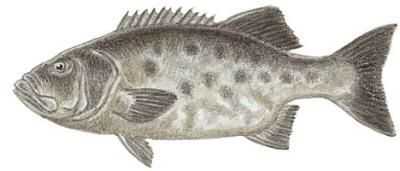Giant Seabass

Species Details
Stereolepis Gigas
Polyprionidae
Perciformes
Onshore, Nearshore, Rocky Bottom, Kelp Forests
60 - 563 lbs.
36" - 88"
Giant Sea Bass (Stereolepis gigas) Fish Description
The Giant Sea Bass is a large native fish found in shallow salt waters. It is bronze in color with dark spots all over its body. It also has white spots that act like “bar codes” for the fish. Scientists use these bar codes to identify an individual and watch the numbers of the giant sea bass. The giant sea bass is carnivorous fish and an apex predator. It eats a variety of fish, mollusks, and crustaceans.
Interesting Facts about the Giant Sea Bass
- Though it is named as a bass, the Giant Sea Bass belongs to the wreckfish family. They’re more related to the Atlantic wreckfish species.
- When they’re juveniles, they have a bright orange color with dark spots. As they grow older, this bright orange color slowly changes to bronze.
- They are the biggest carnivores that dwell in the kelp forests of California.
- They can make booming sounds around 40-80 Hz.
Giant Sea Bass Size and Swim Speed
The giant sea bass is a large fish that can grow up to 7.4 feet and weigh up to 563.5 lbs. It averages 3-6 feet in length and weighs 30-60 lbs. The fish is also known for its longevity; it is speculated that it can live as long as 70 years old. It also matures slowly; it can breed at the age of 11-13 years old. Despite their slow gigantic appearance, they can swim a quick burst to catch their prey or when they’re startled by fishermen.
Giant Sea Bass Habitat and Distribution
The giant sea bass is mainly found in the northern Pacific region. Its range is from southern Mexico to northern California. They are bottom dwellers that thrive in shallow muddy beds, rocky reefs, and kelp forests where they breed, spawn, and hunt. During summer, they’re known to spend shallower waters and then they migrate to deeper waters during winter. The juveniles are seen in depths of 20 to 30 30 feet, while adults are often seen in depths of 30 to 130 feet, but sometimes go deeper.
Popular diving spots for the giant sea bass is Santa Catalina Island. They’re also spotted in the Gulf of California, Channel Islands of California, and Central Coast of California, and occasionally the Point of Conception.
Giant Sea Bass Fishing Tips
The giant sea bass used to be a popular game fish, but since its numbers declined, it is not allowed to keep the fish in California, USA. Occasionally, anglers would accidentally catch a giant black sea bass but they release the fish as soon as possible. You would need to go to Baja California, Mexico to legally catch this fish. Anglers who are going for 30-50 feet deep waters in a steady drift of a boat are the ones who often get a catch of this powerful fish.
There are not many records of the giant sea bass since it is protected, but with a fish that can grow more than 500 lbs. You would have to think of using a piece of equipment specifically for an enormous fish, like the Goliath Grouper. Here are the gears used for a goliath grouper which is also suitable for the giant sea bass. You would need a heavy 7’6 feet spinner rod with a strength of 90 lbs drag and a 400 lbs+ monofilament line. They have an enormous powerful mouth, so use a large hook 20/0 to handle their power. For baits, use large pieces of fish, squids, or crabs attached to lead head jigs or a feather tail. Like the goliath grouper, they’re not shy to take a bite.




